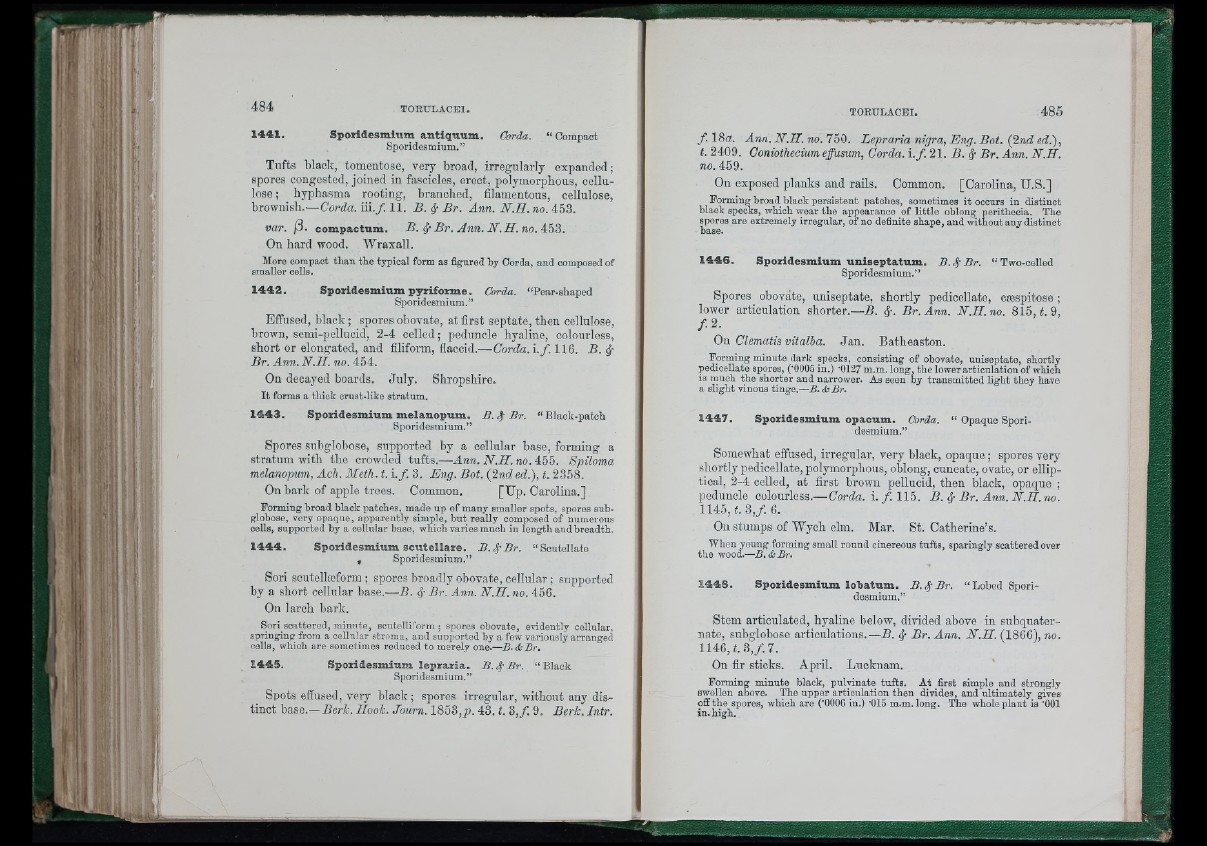
" N
1 4 4 1 . Sp o x ide sm lum a n tiq u um .
Sporidesmium.”
Corda. “ Compact
Tufts black, tomentose, very broad, irregularly expanded;
spores congested, joined in fascicles, erect, polymorpbous, cellulose
; bypbasma rooting, branched, filamentous, cellulose,
brownisb.—Gorda. m .f. 11. B. 4 Br. Ann. N .H . no. 453.
var. (3. com p a c tum . B . 4 Br. Ann. N .H . no. 453.
On bard wood. Wraxall.
More corapaot than the typical form as figured by Corda, and composed of
smaller cells.
1 4 4 2 . S p o zid esm ium p y z ifo zm e . Corda. “Pear-shaped
Sporidesmium.”
Effused, b la ck; spores obovate, at first septate, then cellulose,
brown, semi-pellucid, 2-4 celled; peduncle hyaline, colourless,
short or elongated, and filiform, flaccid.— Corda. i.f. 116. B . 4
Br. Ann. N.H. no. 454.
On decayed boards. July. Shropshire.
I t forms a thick crust-like stratum.
1 4 4 3 . S p o zid esm ium m e la n o p um . U . ^ B r . “ Black-patch
Sporidesmium.”
Spores subglobose, supported by a cellular base, forming a
stratum with the crowded tufts.—Ann. N .H . no. 455. Spiloma
melanopum, Ach. Meth. t. i.f. 3. Eng. Bot. {2nd ed.), t. 2358.
On bark of apple trees. Common. [Up. Carolina.]
Forming hroad black patches, made up of many smaller spots, spores subglobose,
very opaque, apparently simple, but really composed of nnmerous
ceUs, supported by a cellular base, which varies much in length and breadth.
1 4 4 4 . Sp o z id e sm ium s c u t e lla z e .. BB .. 4c B r . “ Scutellate
, Sporidesmium.”
Sori sontellaBform ; spores broadly obovate, cellular; supported
by a short cellular base.—B. 4 B r. Ann. N .H . no. 456.
On larch bark.
Sori scattered, minute, scutellirorm ; spores obovate, evidently cellular,
springing from a cellular stroma, and supported by a few variously arranged
cells, wliich are sometimes reduced to merely one.—B .A B r .
X.44S. S p o zid esm ium lep za z ia . B . ,
Sporidesmium.”
■Br. “ Black
Spots effused, very black; spores irregular, without any distinct
base.—Der«. Hook. Journ. 1853,)». 43. t. 3 ,f. 9. Berk. Intr.
/ . 18a. Ann. N .H . no. 750. Lepraria nigra, Eng. Bot. {2nd edJ),
t. 2409. Coniothecium effusum, Gorda. i.f . 21. B . 4 Br. Ann. N .H .
no. 459.
On exposed planks and rails. Common. [Carolina, U.S.]
Forming broad black persistent patches, sometimes it occurs in distinct
black specks, which wear the appearance of little oblong perithecia. The
sporea are extremely irregular, of no definite shape, and without any distinct
1 4 4 6 . S p o zid esm ium u n is e p ta tum . B . ^ B r . “ Two-oelled
Sporidesmium.”
Spores obovate, uniseptate, shortly pedicellate, cæspitose ;
lower articulation shorter.—B. 4. B r.A n n . N .H . no. 815, i. 9,
f . 2 .
On Clematis vitalha. Jan. Batheaston.
Forming minute dark specks, consisting of obovate, uniseptate, shortly
pedicellate spores, ('0005 in.) '0127 m.m. long, the lower articulation of which
is much the shorter and narrower. As seen by transmitted light they have
a slight vinous tinge.—B. A Br.
1 4 4 7 . S p o zid esm ium o p a cum . Corda. “ Opaque Sporidesmium.”
Somewhat effused, irregular, very black, opaque ; spores very
shortly pedicellate, polymorphous, oblong, cuneate, ovate, or elliptical,
2-4 celled, at first brown pellucid, then black, opaque ;
peduncle colourless.— Gorda. i . f . 115. B. 4 Br. Ann. N.H .no.
1145, t. 3 ,f. 6.
On stumps of Wych elm. Mar. St. Catherine’s.
When young forming small round cinereous tufts, sparingly scattered over
the wood.—B.cfcBn
1 4 4 8 . S p o zid esm ium lo b a tum . B .S pB r.
desmium,”
“ Lobed Spori-
Stem articulated, hyaline below, divided above in subquater-
nate, subglobose articulations.—B. 4 Br. Ann. N .H . (1866), no.
1146, A 3 ,/. 7.
On fir sticks. April. Lucknam.
Forming minute black, pulvinate tnfts. At first simple and strongly
swollen above. The upper articulation then divides, and ultimately gives
off the spores, which are ('0006 in.) '015 m.m. long. The whole plant is '001
in. high.